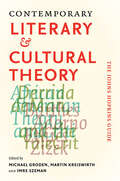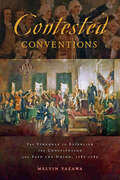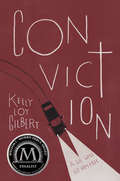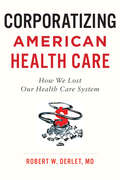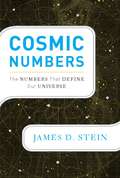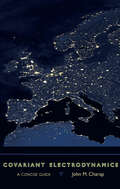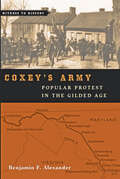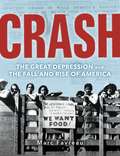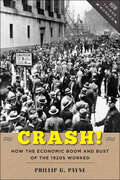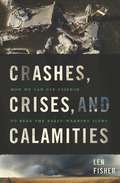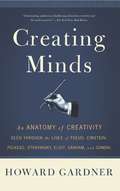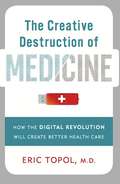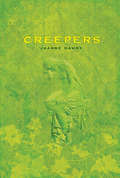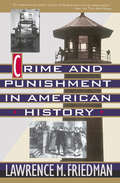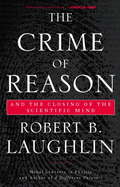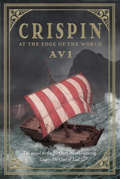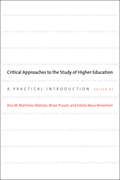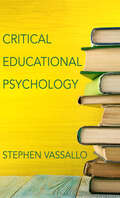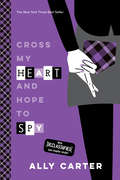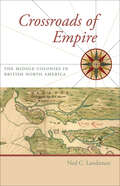- Table View
- List View
Contemporary Literary and Cultural Theory: The Johns Hopkins Guide
by Imre Szeman Michael Groden Martin KreiswirthContemporary Literary and Cultural Theory: The Johns Hopkins Guide is a clear, accessible, and detailed overview of the most important thinkers and topics in the field. Written by specialists from across disciplines, its entries cover contemporary theory from Adorno to Žižek, providing an informative and reliable introduction to a vast, challenging area of inquiry. Materials include newly commissioned articles along with essays drawn from The Johns Hopkins Guide to Literary Theory and Criticism, known as the definitive resource for students and scholars of literary theory and for philosophical reflection on literature and culture.
Contested Conventions: The Struggle to Establish the Constitution and Save the Union, 1787;€“1789
by Melvin YazawaThere is perhaps no more critical juncture in American history than the years in which Americans drafted the federal Constitution, fiercely debated its merits and failings, and adopted it, albeit with reservations. In Contested Conventions, senior historian Melvin Yazawa examines the political and ideological clashes that accompanied the transformation of the country from a loose confederation of states to a more perfect union.Treating the 1787;€“1789 period as a whole, the book highlights the contingent nature of the struggle to establish the Constitution and brings into focus the overriding concern of the framers and ratifiers, who struggled to counter what Alexander Hamilton identified as the "centrifugal" forces driving Americans toward a disastrous disunion. This concern inspired the delegates in Philadelphia to resolve through compromise the two most divisive confrontations of the Constitutional Convention;¢;‚¬;€?representation in the new Congress and slavery;¢;‚¬;€?and was instrumental in gaining ratification even in states where Antifederalist delegates comprised a substantial majority.Arguing that the debates over ratification reflected competing ideas about the meaning of American nationhood, Yazawa illuminates the nature of the crisis that necessitated the meeting at Philadelphia in the first place. Contested Conventions is a cohesive and compelling account of the defining issues that led to the establishment of the Constitution; it should appeal to history students and scholars alike.
Contested Conventions: The Struggle to Establish the Constitution and Save the Union, 1787;€“1789
by Melvin YazawaThere is perhaps no more critical juncture in American history than the years in which Americans drafted the federal Constitution, fiercely debated its merits and failings, and adopted it, albeit with reservations. In Contested Conventions, senior historian Melvin Yazawa examines the political and ideological clashes that accompanied the transformation of the country from a loose confederation of states to a more perfect union.Treating the 1787;€“1789 period as a whole, the book highlights the contingent nature of the struggle to establish the Constitution and brings into focus the overriding concern of the framers and ratifiers, who struggled to counter what Alexander Hamilton identified as the "centrifugal" forces driving Americans toward a disastrous disunion. This concern inspired the delegates in Philadelphia to resolve through compromise the two most divisive confrontations of the Constitutional Convention;¢;‚¬;€?representation in the new Congress and slavery;¢;‚¬;€?and was instrumental in gaining ratification even in states where Antifederalist delegates comprised a substantial majority.Arguing that the debates over ratification reflected competing ideas about the meaning of American nationhood, Yazawa illuminates the nature of the crisis that necessitated the meeting at Philadelphia in the first place. Contested Conventions is a cohesive and compelling account of the defining issues that led to the establishment of the Constitution; it should appeal to history students and scholars alike.
Conviction
by Kelly Loy GilbertA teenage boy faces an impossible choice in this brutally honest debut novel about family, faith, and the ultimate test of conviction, that was the winner of the Children's Choice Book Awards' Teen Choice Debut Author Award.Ten years ago, Braden was given a sign—a promise that his family wouldn't fall apart the way he feared. But Braden got it wrong: his older brother, Trey, has been estranged from the family for almost as long, and his father, the only parent Braden has ever known, has been accused of murder. The arrest of Braden's father, a well-known Christian radio host, has sparked national media attention. His fate lies in his son's hands; Braden is the key witness in his father's upcoming trial.Braden has always measured himself through baseball. He is the star pitcher in his small town of Ornette, and his ninety-four mile per hour pitch already has minor league scouts buzzing in his junior year. Now the rules of the sport that has always been Braden's saving grace are blurred in ways he never realized, and the prospect of playing against Alex Reyes, the nephew of the police officer his father is accused of killing, is haunting his every pitch.
Cook with Amber: Fun, Fresh Recipes to Get You in the Kitchen
by Amber Kelley"Amber's beautiful book is bursting with great ideas that make healthy eating a joy-and she's done a great job covering all the bases that, in my experience, teens and kids really want." -- Jamie Oliver Fifteen-year-old Amber Kelley is inspiring a whole new generation of eaters to get in the kitchen and have fun. She is the first winner of Food Network Star Kids, a member of celebrity chef Jamie Oliver's Food Tube family, and the host of her own web series on Foodnetwork.com and YouTube. Her work has been recognized by First Lady Michelle Obama, and Amber has been featured on national TV networks such as the Disney Channel, E!, and NBC's Today. Now, Amber's 80 most popular and delicious recipes have been hand-picked for her cookbook to empower teens to get in the kitchen. From nourishing breakfasts to start the day right, to school lunches to impress your friends, party ideas for every occasion, and even recipes for the best homemade facial scrubs to fight that dreaded teen acne, Amber shares her secrets for using the power of food to get the best out of her teen years. Includes 45 full-color photographs throughout.
Corporatizing American Health Care: How We Lost Our Health Care System
by Robert W. DerletOver the past three decades, the once-efficient American health care system has evolved into a complex maze of monopolies and a racket of bureaucratic checks, approvals, denials, roadblocks, and detours. This shift has created a massive and at times redundant workforce that frustrates patients, as well as physicians, nurses, and administrative staff. Health care costs the United States over $3 trillion each year and consumes over 18% of the country's gross domestic product. That's more than $11,000 for each person in the country each year—more than double what it costs in most Western European countries to deliver equal or even better care.In Corporatizing American Health Care, Robert W. Derlet, MD, traces the progression of health care policy in the United States. How, he asks, has US health care transformed from bedside medicine—a model of small practices and patient-focused care—into corporate medicine, which prioritizes profit and deals with both patient care and outcomes as billing codes? Arguing that the US Congress is the root of the problem, he describes how Congress has failed to enact legislation to prevent corporate monopolies in the health care industry. Instead, corrupted by large campaign donations and corporate lobbyists, Congress has crafted loopholes benefiting corporations and harming people. Drawing on his decades as a practicing physician caring for thousands of patients, as well as his university and medical school teaching experience, Derlet follows changes to both policy and practice across many sectors of health care. Scrutinizing how hospitals work, he also takes a hard look at high prescription drug prices, unresponsive insurance companies, problems with the Affordable Care Act, the growing medical implant device industry, and even nursing homes. Finally, he explains why the dominance of corporations and their lobbyists over health policy means that we now pay more for our care and our medications but have less choice both in what doctors we see and in what drugs we take. Breaking down the complex ABCs of health care to reveal the unscrupulous practices of the health care industry, Corporatizing American Health Care is perfect for both students and general readers who want to understand the changes in our system from the perspective of an actual doctor.
Corporatizing American Health Care: How We Lost Our Health Care System
by Robert W. DerletOver the past three decades, the once-efficient American health care system has evolved into a complex maze of monopolies and a racket of bureaucratic checks, approvals, denials, roadblocks, and detours. This shift has created a massive and at times redundant workforce that frustrates patients, as well as physicians, nurses, and administrative staff. Health care costs the United States over $3 trillion each year and consumes over 18% of the country's gross domestic product. That's more than $11,000 for each person in the country each year—more than double what it costs in most Western European countries to deliver equal or even better care.In Corporatizing American Health Care, Robert W. Derlet, MD, traces the progression of health care policy in the United States. How, he asks, has US health care transformed from bedside medicine—a model of small practices and patient-focused care—into corporate medicine, which prioritizes profit and deals with both patient care and outcomes as billing codes? Arguing that the US Congress is the root of the problem, he describes how Congress has failed to enact legislation to prevent corporate monopolies in the health care industry. Instead, corrupted by large campaign donations and corporate lobbyists, Congress has crafted loopholes benefiting corporations and harming people. Drawing on his decades as a practicing physician caring for thousands of patients, as well as his university and medical school teaching experience, Derlet follows changes to both policy and practice across many sectors of health care. Scrutinizing how hospitals work, he also takes a hard look at high prescription drug prices, unresponsive insurance companies, problems with the Affordable Care Act, the growing medical implant device industry, and even nursing homes. Finally, he explains why the dominance of corporations and their lobbyists over health policy means that we now pay more for our care and our medications but have less choice both in what doctors we see and in what drugs we take. Breaking down the complex ABCs of health care to reveal the unscrupulous practices of the health care industry, Corporatizing American Health Care is perfect for both students and general readers who want to understand the changes in our system from the perspective of an actual doctor.
Cosmic Numbers: The Numbers That Define Our Universe
by James D. SteinOur fascination with numbers begins when we are children and continues throughout our lives. We start counting our fingers and toes and end up balancing checkbooks and calculating risk. So powerful is the appeal of numbers that many people ascribe to them a mystical significance. Other numbers go beyond the supernatural, working to explain our universe and how it behaves. In Cosmic Numbers, mathematics professor James D. Stein traces the discovery, evolution, and interrelationships of the numbers that define our world. Everyone knows about the speed of light and absolute zero, but numbers like Boltzmann's constant and the Chandrasekhar limit are not as well known, and they do far more than one might imagine: They tell us how this world began and what the future holds. Much more than a gee-whiz collection of facts and figures, Cosmic Numbers illuminates why particular numbers are so important-both to the scientist and to the rest of us.
Covariant Electrodynamics: A Concise Guide
by John M. CharapA notoriously difficult subject, covariant electrodynamics is nonetheless vital for understanding relativistic field theory. John M. Charap’s classroom-tested introduction to the mathematical foundations of the topic presents the material in an approachable manner.Charap begins with a historical overview of electrodynamics and a discussion of the preliminary mathematics one needs in order to grasp the advanced and abstract concepts underlying the theory. He walks the reader through Maxwell’s four equations, explaining how they were developed and demonstrating how they are applied. From there, Charap moves through the other components of electrodynamics, such as Lorentz transformations, tensors, and charged particle behavior. At each point, he carefully works through the mathematics, applies the concepts to simple physical systems, and provides historical context that makes clear the connections among the theories and the mathematicians responsible for developing them. A concluding chapter reviews the history of electrodynamics and points the way for independent testing of the theory.Thorough, evenly paced, and intuitive, this friendly introduction to high-level covariant electrodynamics is a handy and helpful addition to any physicist’s toolkit.
Covariant Electrodynamics: A Concise Guide
by John M. CharapA notoriously difficult subject, covariant electrodynamics is nonetheless vital for understanding relativistic field theory. John M. Charap’s classroom-tested introduction to the mathematical foundations of the topic presents the material in an approachable manner.Charap begins with a historical overview of electrodynamics and a discussion of the preliminary mathematics one needs in order to grasp the advanced and abstract concepts underlying the theory. He walks the reader through Maxwell’s four equations, explaining how they were developed and demonstrating how they are applied. From there, Charap moves through the other components of electrodynamics, such as Lorentz transformations, tensors, and charged particle behavior. At each point, he carefully works through the mathematics, applies the concepts to simple physical systems, and provides historical context that makes clear the connections among the theories and the mathematicians responsible for developing them. A concluding chapter reviews the history of electrodynamics and points the way for independent testing of the theory.Thorough, evenly paced, and intuitive, this friendly introduction to high-level covariant electrodynamics is a handy and helpful addition to any physicist’s toolkit.
Coxey's Army: Popular Protest in the Gilded Age (Witness to History)
by Benjamin F. AlexanderIn 1893, after a major British bank failure, a run on U.S. gold reserves, and a late-June stock-market crash, America was in the throes of a serious economic depression. Unemployment rose, foreclosures climbed, and popular unrest mounted. By the following spring, businessman and Populist agitator Jacob S. Coxey was fed up with government inactivity in the face of the crisis. With the help of eccentric showman Carl Browne, he led a group of several hundred unemployed wage earners, small farmers, and crossroads merchants on a march from Massillon, Ohio, to Washington, D.C., to present a "petition in boots" for government-financed jobs building and repairing the nation’s roads. On May 1, the Coxeyites descended on the center of government, where Coxey attempted to deliver a speech on the Capitol steps. The police attacked, a melee ensued, and Coxey and Browne spent a month in jail. Meanwhile, other Coxey-inspired contingents were on their way east from places as far away as San Francisco and Portland. Some of them even hijacked trains along the way. Who was Coxey, and what motivated himâ€�along with the angry marchers who joined his cause? What did other Americans think of the protesters? Was there ever any chance that the protesters’ demands would be met? Where did the agitators fit in with the politics of their day, and how did their actions jibe with the other labor-related protests happening that year? In this concise and gripping narrative, Benjamin F. Alexander contextualizes the march by vividly describing the misery wrought by the Panic of ’93. Alexander brings both Coxey and his fellow leaders to life, along with the reporters and spies who traveled with them and the diverse group of captivated newspaper readers who followed the progress of the marches and train heists.Coxey’s Army explains how the demands of the Coxeyitesâ€�far from being the wild schemes of a small group of cranksâ€�fit into a larger history of economic theories that received serious attention long before and long after the Coxey march. Despite running a gauntlet of ridicule, the marchers laid down a rough outline of what, some forty years later, emerged as the New Deal.
Crash: The Great Depression and the Fall and Rise of America
by Marc FavreauThe incredible true story of how real people weathered one of the most turbulent periods in American history—the Great Depression—and emerged triumphant. From the sweeping consequences of the stock market crash to the riveting stories of individuals and communities caught up in a real American dystopia, discover how the country we live in today was built in response to a time when people from all walks of life fell victim to poverty, insecurity, and fear. Meet fascinating historical characters like Herbert Hoover, Franklin Delano and Eleanor Roosevelt, Frances Perkins, Dorothea Lange, Walter White, and Mary McLeod Bethune. See what life was like for regular Americans as the country went from the highs of the Roaring Twenties to the lows of the Great Depression, before bouncing back again during World War II. Explore pivotal scenes such as the creation of the New Deal, life in the Dust Bowl, the sit-down strikes in Michigan, the Scottsboro case, and the rise of Father Coughlin. Packed with photographs and firsthand accounts, and written with a keen understanding of the upheaval of the 1930s, Crash shares the incredible story of how America survived—and, ultimately, thrived.
Crash!: How the Economic Boom and Bust of the 1920s Worked (How Things Worked)
by Phillip G. PayneSpeculation�an economic reality for centuries�is a hallmark of the modern U.S. economy. But how does speculation work? Is it really caused, as some insist, by popular delusions and the madness of crowds, or do failed regulations play a greater part? And why is it that investors never seem to learn the lessons of past speculative bubbles? Crash! explores these questions by examining the rise and fall of the American economy in the 1920s.Phillip G. Payne frames the story of the 1929 stock market crash within the booming New Era economy of the 1920s and the bust of the Great Depression. Taking into account the emotional drivers of the consumer market, he offers a clear, concise explanation of speculation's complex role in creating one of the greatest financial panics in U. S. history.Crash! explains how postWorld War I changes in the global financial markets transformed the world economy, examines the role of boosters and politicians in promoting speculation, and describes in detail the disastrous aftermath of the 1929 panic. Payne's book will help students recognize the telltale signs of bubbles and busts, so that they may become savvier consumers and investors.
Crashes, Crises, and Calamities: How We Can Use Science to Read the Early-Warning Signs
by Len FisherWhy do certain civilizations, societies, and ecosystems collapse? How does the domino effect relate to the credit crunch? When can mathematics help explain marriage? And how on earth do toads predict earthquakes? The future is uncertain. But science can help foretell what lies ahead.Drawing on ecology and biology, math and physics, Crashes, Crises, and Calamities offers four fundamental tools that scientists and engineers use to forecast the likelihood of sudden change: stability, catastrophe, complexity, and game theories. In accessible prose, Len Fisher demonstrates how we can foresee and manage events that might otherwise catch us by surprise.At the cutting edge of science, Fisher helps us find ways to act before a full-fledged catastrophe is upon us. Crashes, Crises, and Calamities is a witty and informative exploration of the chaos, complexity, and patterns of our daily lives.
Creating Minds: An Anatomy of Creativity as Seen Through the Lives of Freud, Einstein, Picasso, Stravinsky, Eliot, G
by Howard E. GardnerThis peerless classic guide to the creative self uses portraits of seven extraordinary individuals to reveal the patterns that drive the creative process -- to demonstrate how circumstance also plays an indispensable role in creative success.Howard Gardner changed the way the world thinks about intelligence. In his classic work Frames of Mind, he undermined the common notion that intelligence is a single capacity that every human being possesses to a greater or lesser extent. With Creating Minds, Gardner gives us a path breaking view of creativity, along with riveting portraits of seven figures who each reinvented an area of human endeavor. Using as a point of departure his concept of seven "intelligences," ranging from musical intelligence to the intelligence involved in understanding oneself, Gardner examines seven extraordinary individuals -- Sigmund Freud, Albert Einstein, Pablo Picasso, Igor Stravinsky, T.S. Eliot, Martha Graham, and Mahatma Gandhi -- each an outstanding exemplar of one kind of intelligence. Understanding the nature of their disparate creative breakthroughs not only sheds light on their achievements but also helps to elucidate the "modern era" -- the times that formed these creators and which they in turn helped to define. While focusing on the moment of each creator's most significant breakthrough, Gardner discovers patterns crucial to our understanding of the creative process. Creative people feature unusual combinations of intelligence and personality, and Gardner delineates the indispensable role of the circumstances in which an individual's creativity can thrive -- and how extraordinary creativity almost always carries with it extraordinary human costs.
The Creative Destruction of Medicine: How the Digital Revolution Will Create Better Health Care
by Eric TopolHow genomics, big data, and digital technology are revolutionizing every aspect of medicine, from physical exams to drug prescriptions to organ transplantsMobile technology has transformed our lives, and personal genomics is revolutionizing biology. But despite the availability of technologies that can provide wireless, personalized health care at lower cost, the medical community has resisted change. In The Creative Destruction of Medicine, Eric Topol-one of the nation's top physicians-calls for consumer activism to demand innovation and the democratization of medical care. The Creative Destruction of Medicine is the definitive account of the coming disruption of medicine, written by the field's leading voice.
Creepers
by Joanne DahmeFrom moving to a new house to making new friends and preparing for high school, life for the new girl in town can be unsettling. But thirteen year-old Courtney is unprepared for how creepy life in Murmur, Massachusetts turns out to be. Her ivy-covered house overlooking the antiquated cemetery next door is one thing, but Courtney finds herself thrust into a full-fledged haunted adventure after meeting Christian and Margaret Geyer, a strange father and daughter with unfinished family business. The body of their ancestor, Prudence, has gone missing from beneath her ivy-carved tombstone and must be returned to its final resting place in order to break the spell that looms over Courtney's house. To add to the suspense and help solve the mystery, authentic documents and photographs are set at the beginning of each chapter pertaining to Murmur, Courtney's house, and the infamous cemetery. Will Courtney uncover the secret lurking within the dark, dank underbelly of her ivy-covered basement?
Crime And Punishment In American History
by Lawrence FriedmanIn a panoramic history of our criminal justice system from Colonial times to today, one of our foremost legal thinkers shows how America fashioned a system of crime and punishment in its own image.
The Crime of Reason: And the Closing of the Scientific Mind
by Robert B. LaughlinWe all agree that the free flow of ideas is essential to creativity. And we like to believe that in our modern, technological world, information is more freely available and flows faster than ever before. But according to Nobel Laureate Robert Laughlin, acquiring information is becoming a danger or even a crime. Increasingly, the really valuable information is private property or a state secret, with the result that it is now easy for a flash of insight, entirely innocently, to infringe a patent or threaten national security. The public pays little attention because this vital information is "technical”-but, Laughlin argues, information is often labeled technical so it can be sequestered, not sequestered because it's technical. The increasing restrictions on information in such fields as cryptography, biotechnology, and computer software design are creating a new Dark Age: a time characterized not by light and truth but by disinformation and ignorance. Thus we find ourselves dealing more and more with the Crime of Reason, the antisocial and sometimes outright illegal nature of certain intellectual activities.The Crime of Reason is a reader-friendly jeremiad, On Bullshit for the Slashdot and Creative Commons crowd: a short, fiercely argued essay on a problem of increasing concern to people at the frontiers of new ideas.
Crispin: At the Edge of the World (Crispin)
by AviIn this riveting sequel to the Newbery-Award winning Crispin: The Cross of Lead--the second book in a planned trilogy--Avi explores themes of war, religion, and family as he continues the adventures of Crispin and Bear.The more I came to know of the world, the more I knew I knew it not.He was a nameless orphan, marked for death by his masters for an unknown crime. Discovering his name- Crispin-only intensified the mystery. Then Crispin met Bear, who helped him learn the secret of his full identity. And in Bear-the enormous, red-bearded juggler, sometime spy, and everyday philosopher-Crispin also found a new father and a new world.Now Crispin and Bear have set off to live their lives as free men. But they don't get far before their past catches up with them: Bear is being pursued by members of the secret brotherhood who believe he is an informer. When Bear is badly wounded, it is up to Crispin to make decisions about their future-where to go, whom to trust. Along the way they become entangled with an extraordinary range of people, each of whom affects Crispin and Bear's journey in unexpected ways. To find freedom and safety, they may have to travel to the edge of the world-even if it means confronting death itself.
Critical Approaches to the Study of Higher Education: A Practical Introduction
by Ana M. MartÃnez-Alemán Brian Pusser Estela Mara BensimonCritical theory has much to teach us about higher education. By linking critical models, methods, and research tools with an advocacy-driven vision of the central challenges facing postsecondary researchers and staff, Critical Approaches to the Study of Higher Education makes a significantâ€â€?and long overdueâ€â€?contribution to the development of the field. The contributors argue that, far from being overly abstract, critical tools and methods are central to contemporary scholarship and can have practical policy implications when brought to the study of higher education. They argue that critical research design and critical theories help scholars see beyond the normative models and frameworks that have long limited our understanding of students, faculty, institutions, the organization and governance of higher education, and the policies that shape the postsecondary arena. A rigorous and invaluable guide for researchers seeking innovative approaches to higher education and the morass of traditionally functionalist, rational, and neoliberal thinking that mars the field, this book is also essential for instructors who wish to incorporate the lessons of critical scholarship into their course development, curriculum, and pedagogy.
Critical Educational Psychology: An Examination Of Foundational Features Of The Field (Educational Psychology Ser. #15)
by Stephen VassalloThe field of critical studies recognizes that all knowledge is deeply embedded in ideological, cultural, political, and historical contexts. Although this approach is commonly applied in other subfields of psychology, educational psychology;¢;‚¬;€?which is the study of human learning, thinking, and behavior in formal and informal educational contexts;¢;‚¬;€?has resisted a comprehensive critical appraisal. In Critical Educational Psychology, Stephen Vassallo seeks to correct this deficit by demonstrating how the psychology of learning is neither neutral nor value-free but rather bound by a host of contextual issues and assumptions. Vassallo invites teachers and teacher educators, educational researchers, and educational psychologists to think broadly about the implications that their use of psychology has on the teaching and learning process. He applies a wide variety of interdisciplinary approaches to examine the psychology of learning, cognitive development, motivation, creativity, discipline, and attention. Drawing on multiple perspectives within psychology and critical theory, he reveals that contemporary educational psychology is entangled in and underpinned by specific political, ideological, historical, and cultural contexts.A valuable resource for anyone who relies on psychology to interact with, assess, and deliberate over others, especially school-aged children, Critical Educational Psychology resists neatly packaged theories, models, and perspectives that are intended to bring some basis and certainty to pedagogical decision-making. This book will enhance teachers;€™ ethical decision-making and start important new conversations about power and opportunity.
Critical Educational Psychology
by Stephen VassalloThe field of critical studies recognizes that all knowledge is deeply embedded in ideological, cultural, political, and historical contexts. Although this approach is commonly applied in other subfields of psychology, educational psychology;¢;‚¬;€?which is the study of human learning, thinking, and behavior in formal and informal educational contexts;¢;‚¬;€?has resisted a comprehensive critical appraisal. In Critical Educational Psychology, Stephen Vassallo seeks to correct this deficit by demonstrating how the psychology of learning is neither neutral nor value-free but rather bound by a host of contextual issues and assumptions. Vassallo invites teachers and teacher educators, educational researchers, and educational psychologists to think broadly about the implications that their use of psychology has on the teaching and learning process. He applies a wide variety of interdisciplinary approaches to examine the psychology of learning, cognitive development, motivation, creativity, discipline, and attention. Drawing on multiple perspectives within psychology and critical theory, he reveals that contemporary educational psychology is entangled in and underpinned by specific political, ideological, historical, and cultural contexts.A valuable resource for anyone who relies on psychology to interact with, assess, and deliberate over others, especially school-aged children, Critical Educational Psychology resists neatly packaged theories, models, and perspectives that are intended to bring some basis and certainty to pedagogical decision-making. This book will enhance teachers;€™ ethical decision-making and start important new conversations about power and opportunity.
Cross My Heart and Hope to Spy (Gallagher Girls #2)
by Ally CarterAfter the excitement of the fall, all Cammie Morgan wants is peaceful semester at school. But that's easier said than done when you're a CIA legacy and go to the premier school in the world...for spies.Despite Cammie's best intentions, trouble crops up quickly. Cammie, Bex, and Liz learn that the Gallagher Academy is hosting guests from another spy school -- a school that is known to the world as the Ethan Frome Academy--a secret spy school for boys. After her fiasco with Josh last fall, Cammie isn't sure she's ready for daily encounters with boy spies especially after she meets Zach -- an incorrigibe cutie who everyone thinks is just perfect. Cammie is right to be worried about their new guests. Soon after the boys' arrival, she's blamed for a series of security breaches that leave the school's top-secret status at risk. And the perfectly crushable Zach is her prime suspect.
Crossroads of Empire: The Middle Colonies in British North America (Regional Perspectives on Early America)
by Ned C. LandsmanThis work examines the Middle Colonies—New York, New Jersey, and Pennsylvania—as a region at the center of imperial contests among competing European powers and Native American nations and at the fulcrum of an emerging British-Atlantic world of culture and trade.Ned C. Landsman traces the history of the Middle Colonies to address questions essential to understanding their role in the colonial era. He probes the concept of regionality and argues that while each territory possessed varying social, religious, and political cultures, the collective lands of New York, New Jersey, and Pennsylvania came to function as a region because of their particular history and their distinct place in the imperial and Atlantic worlds. Landsman demonstrates that the societal cohesiveness of the three colonies originated in the commercial and military rivalries among Native nations and developed further with the competing involvement of the European powers, eventually emerging as the focal point in the contest for dominion over North America. In relating this progression, Landsman discusses various factors in the region's development, including the Enlightenment, evangelical religion, factional politics, religious and ethnic diversity, and distinct systems of Protestant pluralism. Ultimately, he argues, it was within the Middle Colonies that the question was first posed, What is the American?An insightful and valuable classroom synthesis of the scholarship of the Middle Colonies, Crossroads of Empire makes clear the vital role of New York, New Jersey, and Pennsylvania in establishing an American identity.
